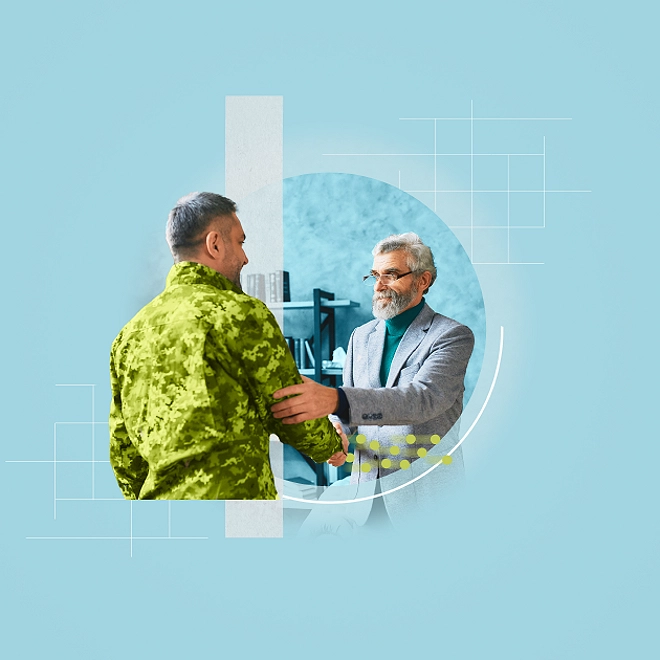End-to-end justice
Creating a more just society calls for collaboration and resource-sharing across the justice system and beyond with businesses, nonprofits, and communities
Introduction
“Who is not against child labor?” That is the question that occurred to Alberto Mora when he was general counsel for an international food and candy company.1 Traveling to Ghana to visit the farms where cocoa was harvested, he quickly realized the situation was more complicated. Much of the cocoa was grown on family farms of 1–2 acres, where cocoa pods were laboriously harvested by hand with machetes and baskets. While these families desperately wanted their children to get an education (without exception, none of the families Alberto met with wanted their children to follow them into cocoa farming), they had very limited resources. So, if another family member fell ill or there was another problem, they often had no choice but to pull their children from school to be able to turn in the harvest.
A trained lawyer, Mora came to understand that simply passing a law against child labor would not change this situation. But he also saw that his company could play a role and, indeed, had to play a role. Much of the child labor he encountered in Africa resulted from the economic realities faced by poor families living on the margin. Being against child labor required more than just regulatory compliance; it demanded that companies also work to improve the economic situation of their farmers, providing them with the resources to hire workers so that they could both earn a more secure livelihood and still send their children to school.
Improving the economic situation of farmers in West Africa is a complex problem that even a large multinational company cannot affect alone. In this way, it illustrates one of the major trends emerging in justice today: creating a more effective and equitable justice system takes more than laws and police; it takes organizations from the public and private sectors working together to tackle some of society’s most difficult challenges, particularly for those at the bottom of the production chain.
Justice is not the purview of a single government entity. It takes shape from multiple moving parts, including government agencies, civil society, the private sector, and policies that influence incentives in our communities. Even the three major components of the justice system—courts, corrections, and law enforcement—are themselves made up of thousands of moving parts. Law enforcement in the United States alone includes more than 18,000 distinct police departments at the federal, state, county, and local levels.2
As a result, achieving a justice system’s desired outcomes—whether a reduction in crime or swifter, fairer operations—demands collaboration. An effective justice system works together.
Take court backlogs. Backlogs, like other outcomes of the justice system, are a complex phenomenon beyond the control of any one organization. A 2021 report found that each US state and local court faces an average backlog of 1,274 cases.3 The Hawaiian Island of Oahu’s courts were no exception. However, an analysis of Oahu’s backlogs revealed a large chunk of cases belonged to a relatively small group of repeat offenders in the homeless population—with an average of over 10 cases each. They faced violations related to homelessness, such as sitting or sleeping on sidewalks. This wasn’t an issue of courts needing to move faster—it was of courts being the wrong venue. The Prosecutor and Public Defenders’ offices collaborated to create an alternative—the Community Outreach Court, with multiple locations across Oahu. The alternative court cleared 601 cases in its first year by focusing on solving homelessness rather than on prosecution.4
Walls coming down
- Sharing data, budgets, programs, intelligence, and other resources among different components of the justice system not only curtails errors and redundancies but also enhances the capacity of justice organizations to fulfill their mission.
- Proactive collaboration between justice organizations and other government entities when dealing with common issues reduces friction and enhances efficiency.
- Partnerships between justice organizations and nongovernmental entities such as commercial companies, universities, civic organizations, and community groups make the justice system more responsive to public needs and resilient to sudden shocks (see infographic, By the numbers: End-to-end justice).

Trend in action
Complex problems typically cut across the remits of different organizations and sectors. Breaking the barriers between organizations creates more opportunities for collaboration and data-sharing, helping justice organizations make progress on the toughest challenges they face.
Unlocking efficiencies within the justice system
Justice organizations are not monolithic. Courts pursue very different missions than law enforcement or corrections. Yet, the common goal of creating a more just society creates interdependencies.
Sharing information, resources, or expertise among justice organizations can improve outcomes. For example, India is setting up the Interoperable Criminal Justice System (ICJS), a cloud-based national platform to enable the seamless transfer of data and information among different pillars of the criminal justice system, including police, courts, jails, and forensic science laboratories. In Phase I of the project, designers implemented and stabilized individual IT systems. They also enabled a function to search records. Phase II, which is targeted for completion by 2026, will build on the system to enable the principle of “one data, one entry,” whereby data entered once in a single pillar is seamlessly available in all other pillars.5 By enabling seamless data-sharing, the ICJS platform aims to increase effectiveness and efficiency across the criminal justice system. Providing all the relevant case information to courts in real time should enhance case and court management. The analytics built into the platform will also help improve investigations and enable lawmakers to make timely, evidence-based decisions.6
Coordinating interagency response
The very nature of a justice organization’s work brings it in close proximity to other government agencies. For example, when responding to violent crime, the police collaborate with traffic, emergency medical, and health agencies on the same incident.
Agencies have disparate missions, cultures, and processes. They also have different areas of expertise. Collaboration, done effectively, can provide beneficial perspectives and aligned goals. Proactive collaboration even allows agencies to establish protocols for situations involving multiple jurisdictions, like the interagency incident command structure developed after Hurricane Katrina.7
Collaboration is key to police helping people undergoing a mental health crisis. It is estimated that at least 20% of police calls for service in the United States involve a person with a mental illness or substance abuse.8 Such calls require more of a police officer’s time than burglaries, assaults, or traffic accidents.9 While the police are trained to investigate crime, they typically are not equipped to support mental health crises. Therefore, many cities are experimenting with coresponder programs, where teams of police officers and social workers respond to calls together. The logic for such partnerships is clear; getting more people into social programs not only helps them overcome their crises but also lightens the load on police, freeing up resources for crimes within their training. For example, the Denver Police Department has partnered with the Mental Health Center of Denver to launch the Crisis Intervention Response Unit (CIRU). CIRU is a coresponder program in which trained clinicians ride along with police officers to offer assistance to people suffering from mental, or substance-use issues.10 Coresponder programs not only help people dealing with mental or substance-abuse crises, but they also save money. A coresponder program implemented in Eugene, Oregon, saved the city more than US$14 million in ambulance rides and emergency room visits in 2018 alone.11
Deploying community-enabled solutions
Crime doesn’t happen in a vacuum. It affects everyone in some form, be they citizens, businesses, or nonprofits. With the involvement of this wide swathe of stakeholders, the past few years have witnessed a rise in community-driven solutions to tackle some of society’s biggest problems, including crime. Justice organizations and the government at large are increasingly collaborating with an extensive network of problem-solvers.
Take, for instance, cybercrime. Cyberattacks have become increasingly pervasive. Their targets are widespread—citizens, universities, businesses, and governments. The current stream of attacks may be the tip of the iceberg. It is estimated that there will be new ransomware attacks every two seconds by 2031, up from every 11 seconds in 2021.12 The sheer scale of cyberattacks makes it impossible for any single organization, government, or even a country to have visibility into the entire spectrum of cybercrime, let alone deploy countermeasures. Therefore, countries are beginning to share information and take collaborative action against cybercrime.
One transnational public-private cybersecurity collaboration took down Emotet, the world’s largest botnet. Europol, the European Union’s law enforcement agency, led a coalition of law enforcement agencies from eight countries—the United States, Canada, the United Kingdom, the Netherlands, Germany, France, Lithuania, and Ukraine—and private security researchers to eradicate the Emotet infrastructure.13 To disrupt Emotet, law enforcement agencies and a large group of security industry players collaborated to simultaneously hijack hundreds of Emotet’s command and control infrastructure (spread across more than 90 countries). The expertise of technology firms also played a critical role in the global takedown. For instance, in the United States, Team Cymru—a threat intelligence company—helped the US Federal Bureau of Investigation (FBI) pull off the operation. The company detailed and validated the IP addresses of Emotet’s controllers and recruited network operators to help take down the servers.14
Dutch investments to tackle organized crime
Organized crime doesn’t respect borders. It cuts across nations, and its negative impacts touch every aspect of the justice system. So, when authorities in the Netherlands decided to tackle organized crime, they did so not with a single investment but with many investments spread out across both justice organizations and industry. The goal was not just to catch more criminals but to deprive criminals of the opportunity to commit crimes.15
That goal required actions that prevented, disrupted, and punished crime:
- Prevention. Recognizing that turning youth away from a life of crime would deprive organized crime of a key source of new recruits, Dutch authorities dedicated €103 million to programs for youth workers, teachers, and community officials to divert youth from crime.16
- Disruption. Denying the opportunity to commit a crime also means disrupting criminal activity where it takes place, often in public markets and places. Therefore, Dutch investments spread beyond purely government organizations and extended to private industry as well. For example, €73 million was dedicated to beefing up screening and surveillance at ports and airports, while another €10 million went to entrepreneurs to counter money laundering and help spot illegal activity.17
- Punishment. Organized crime leaders stop at nothing to continue running their operations, even from behind bars. Therefore, authorities in the Netherlands invested €34 million in corrections to establish a higher-security division of prisons to house organized crime leaders to help prevent them from continuing to run the business while incarcerated.18 By working with courts to adopt video hearings, corrections officials can even cut down on escape risk by reducing the need for high-risk transits to court.
Complex justice problems such as countering organized crime defy easy solutions. They take concerted efforts spread across many players, both within and outside government.
Moving forward
- Align on a common vision. Proactively engaging with multiple stakeholders can help justice organizations set community-defined goals, which can in turn help justice organizations think of outside-the-box approaches to solving challenges. Further, setting measurable metrics of success in achieving those goals can align priorities, operations, and resources to better match the needs of the broader community.
- Execution by network. Justice organizations should nurture collaborative public-private ecosystems of technology companies, universities, research labs, and other public sector entities. These ecosystems can contribute to collective intelligence that exponentially increase justice organizations’ ability to mitigate society’s biggest challenges.
- Set clear expectations and boundaries for collaboration. Setting terms and establishing protocols at the onset of collaboration helps define each organization’s role in situations involving multiple organizations. It also helps organizations avoid overstepping boundaries.
- Look to peers for examples of success. While no two justice systems are identical, many are wrestling with the same challenges. Therefore, establishing “coalitions of the willing” of justice organizations grappling with similar challenges can help surface success stories, gather data on what works and why, and accelerate the success of end-to-end justice for all participants.
My take
Toby Hayward-Butcher, head of strategy and delivery for BOLD, UK Ministry of Justice
Connecting data to better help society’s most vulnerable
Governments around the world hold vast amounts of data, but it’s not always in the best shape. Our data sets have grown organically over decades; as a result, they vary in quality, are sometimes on outdated systems, and are often held across multiple departments.
In the United Kingdom, we recognized that improving and joining some of those data sets could help us better design support for the people we want to help. For example, suppose we could link employment data to prison data. In that case, we could better understand whether the rehabilitative interventions we provide to prisoners are helping them find work when they leave prison. That’s why we set up the Better Outcomes through Linked Data (BOLD) program.
BOLD is focused on four pilot projects: reducing homelessness, supporting victims of crime, reducing substance misuse, and reducing reoffending. Ultimately, the program seeks to understand peoples’ pathways in these areas—and crucially, the interplay between them—to identify which government interventions make a difference. We want to know how best to support people and invest taxpayer’s money.
Our approach focuses on “use cases,” so we start with real-world applications in mind where linking data could lead to improvements. From there, we identify which datasets to link, analyze the linked data to generate insights, and augment our findings with user research. The use-case approach means we don’t look for data for the sake of it, and we don’t deploy technology just because we can—we see both data and technology as enablers for the improvements we want to unlock.
Of course, linking data is not straightforward. Across the United Kingdom’s Government departments, there isn’t yet a central catalog of data sets, and we pseudonymize data to ensure privacy is respected at every step.
But the overarching challenge is creating shared incentives between different agencies and departments to collaborate and share their data. In contrast to the traditional transactional model of data-sharing across government, BOLD is a cross-government program designed upon the shared problems that government departments will be motivated to collaborate on. We have hired staff into multiple government departments (health, justice, housing), and they all work out of those departments but as part of a single unified program.
Data linking in government and public services has transformative potential—and the BOLD program aims to show precisely that.
Deloitte Center for Government Insights
The Deloitte Center for Government Insights shares inspiring stories of government innovation, looking at what’s behind the adoption of new technologies and management practices. We produce cutting-edge research that guides public officials without burying them in jargon and minutiae, crystalizing essential insights in an easy-to-absorb format. Through research, forums, and immersive workshops, our goal is to provide public officials, policy professionals, and members of the media with fresh insights that advance an understanding of what is possible in government transformation.
Defense, Security & Justice
Deloitte offers national security consulting and advisory services to clients across the Department of Defense, the Department of Homeland Security, the Department of Justice, and the intelligence community. From cyber and logistics to data visualization and mission analytics, personnel, and finance, we bring insights from our client experience and research to drive bold and lasting results in the national security and intelligence sector. Our people, ideas, technology, and outcomes are all designed for impact.



